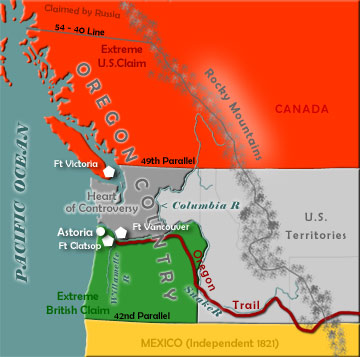The Oregon Treaty is a treaty between the United Kingdom and the United States that was signed on June 15, 1846, in Washington, D.C. The treaty brought an end to the Oregon boundary dispute by settling competing American and British claims to the Oregon Country, which had been jointly occupied by both Britain and the U.S. since the Treaty of 1818.
Background

The Treaty of 1818 set the boundary between the United States and British North America along the 49th parallel of north latitude from Minnesota to the "Stony Mountains" (now known as the Rocky Mountains). West of those mountains was known to the Americans as the Oregon Country and to the British as the Columbia Department or Columbia District of the Hudson's Bay Company. (Also included in the region was the southern portion of another fur district, New Caledonia.) The treaty provided for joint control of that land for ten years. Both countries could claim land and both were guaranteed free navigation throughout.
Joint control steadily grew less tolerable for both sides. After a British minister rejected U.S. President James K. Polk's offer to settle the boundary at the 49th parallel north, Democratic expansionists militantly called for the annexation of the entire region up to Parallel 54°40′ north, the southern limit of Russian America as established by parallel treaties between the Russian Empire and the United States (1824) and Britain (1825). However, after the outbreak of the Mexican-American War in April 1846 diverted U.S. attention and military resources, a compromise was reached in the ongoing negotiations in Washington, D.C., and the matter was settled by the Polk administration (to the dismay of its own party's militant hardliners) to avoid a two-war situation and the third war with the formidable military strength of Great Britain in less than 70 years.
Negotiations

The treaty was negotiated by U.S. Secretary of State James Buchanan, who later became president, and Richard Pakenham, British envoy to the United States and member of the Privy Council of the United Kingdom for Queen Victoria. The treaty was signed on June 15, 1846.
The Oregon Treaty set the U.S. and British North American border at the 49th parallel with the exception of Vancouver Island, which was retained in its entirety by the British. Vancouver Island, with all coastal islands, was constituted as the Colony of Vancouver Island in 1849. The U.S. portion of the region was organized as Oregon Territory on August 14, 1848, with Washington Territory being formed from it in 1853. The British portion remained unorganized until 1858 when the Colony of British Columbia was declared as a result of the Fraser Canyon Gold Rush and fears of re-asserted American expansionist intentions. The two British colonies were amalgamated in 1866 as the United Colonies of Vancouver Island and British Columbia. When the Colony of British Columbia joined Canada in 1871, the 49th Parallel and marine boundaries established by the Oregon Treaty became the U.S.-Canadian border.
Treaty definitions

The treaty defined the border in the Strait of Juan de Fuca through the major channel. The "major channel" was not defined, giving rise to further disputes in the San Juan Islands in 1859. Other provisions included:
- Navigation of "channel[s] and straits, south of the forty-ninth parallel of north latitude, remain free and open to both parties."
- The "Puget's Sound Agricultural Company" (a subsidiary of the Hudson's Bay Company) retains the right to their property north of the Columbia River, and shall be compensated for properties surrendered if required by the United States.
- The property rights of the Hudson's Bay Company and all British subjects south of the new boundary will be respected.
Issues arising from the treaty

Ambiguities in the wording of the Oregon Treaty regarding the route of the boundary, which was to follow "the deepest channel" out to the Strait of Juan de Fuca and beyond to the open ocean resulted in the Pig War; another boundary dispute in 1859 over the San Juan Islands. The dispute was peacefully resolved after a decade of confrontation and military bluster during which the local British authorities consistently lobbied London to seize back the Puget Sound region entirely, as the Americans were busy elsewhere with the Civil War. The San Juan's dispute was not resolved until 1872; when the pursuant to the Treaty of Washington (1871) an arbitrator (the German Emperor) chose the American-preferred marine boundary via Haro Strait, to the west of the islands, over the British preference for Rosario Strait which lay to their east.
The treaty also had the unintended consequence of putting what became Point Roberts, Washington on the "wrong" side of the border. A peninsula jutting south from Canada into Boundary Bay, the agreement made the land south of the 49th parallel a separate fragment of the United States.







0 comments:
Post a Comment